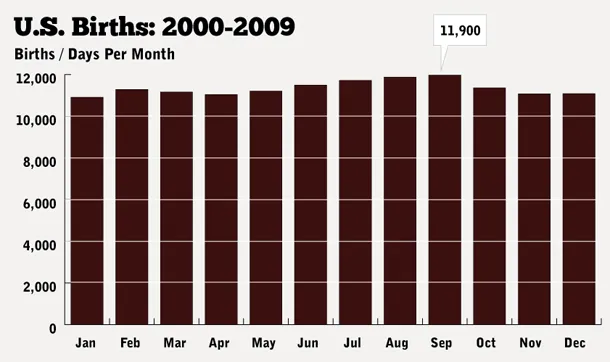
How Common Is Your Birthday? Pt. 2.
Last weekend's birthday heatmap post has been hugely popular by The Daily Viz standards, drawing in more than 100,000 readers and tons of social media attention. While I'm excited about the traffic, I'm also worried that the graphic may have misled some readers.
Some people read the map assuming that darker shades represented higher numbers of actual births, even though I tried to explain in the post that the colors were shaded by birthday rank, from 1 to 366, in popularity. Or I thought I did. Because of that, Sept. 16 — the most popular birthday — seems wildly more common than January 1, among the least popular. Both may be relatively close in the raw number of births, even though their ranks are far apart.
Unfortunately, I haven't yet been able to acquire a list of all dates and total births for each. But last night I compiled a decade's worth of nationwide birth data by month. Those data show that August, in fact, saw the most births during the 10-year period. Each month is over 3.1 million births, however:
August, of course, has an extra day for potential births, so I created an average births by month field. Viewed that way, September did have more births relative to its size. But notice there isn't much difference between months in the distribution of the births. Alas, all our birthdays are probably pretty normal:
I should note that this blog is a place for me to experiment with visualization techniques in my own time, and I will occasionally make bad design choices or produce work that is less useful to some. This is one of those times, I suppose. Thanks to Dan DeFelippi, Waldo Jaquith and several others who prompted this post. Download the data if you want to create your own visualizations.
Data source: Centers for Disease Control, National Vital Statistics Reports

